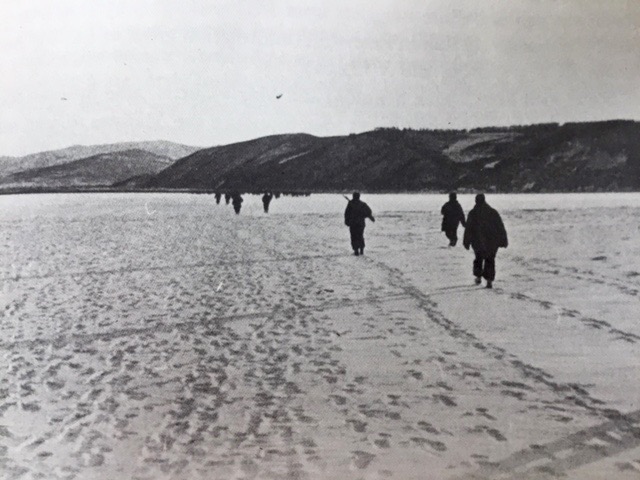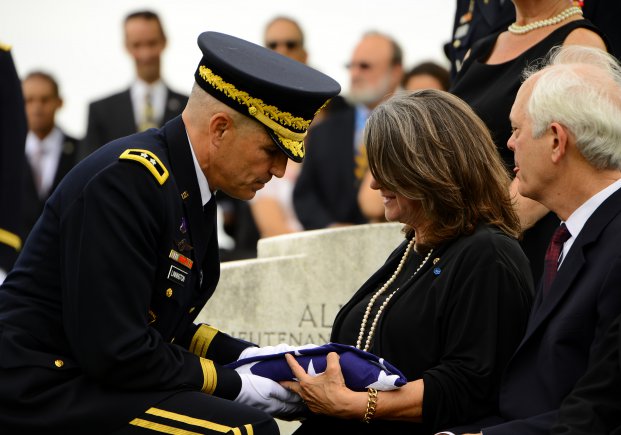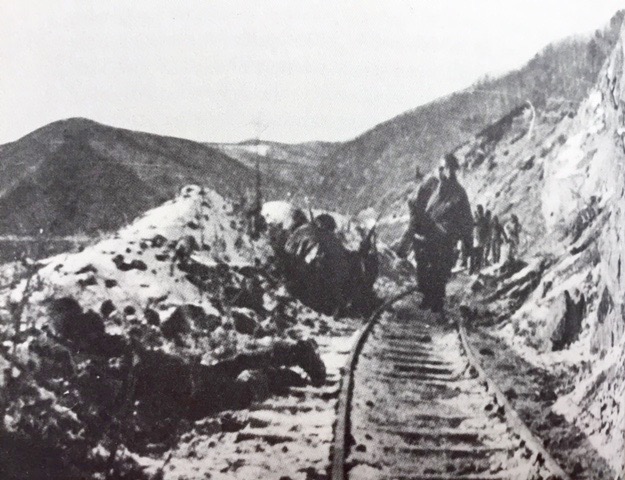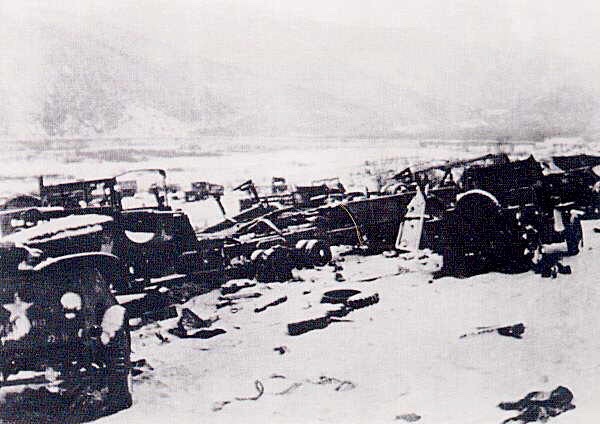On the East Side of Chosin

As the helicopter took off and disappeared over the North Korean mountains, Lt. Col. Don Faith, watching from his desolate, wind-swept command post at Chosin Reservoir, threw his newly awarded Silver Star into the snow. After enduring a horrific night of fighting against overwhelming Chinese forces, his commanding officer had just ordered him and his men to continue defending their position. "Don’t let a bunch of Chinese laundrymen stop you,” he’d been told.
Lt. Colonel Don Faith
For Faith and over a thousand men of the 31st Regimental Combat Team (RCT-31), the decision to postpone their move from east of Chosin, or Changjin, in late November 1950 would prove fatal.
Over the next four days, the 32-year-old World War II veteran, husband, and father would courageously lead his men against relentless Chinese attacks. For his heroic actions during the attempted breakout from one of the most devastating entrapments in US Army history, Faith was posthumously awarded the Congressional Medal of Honor, the only battalion commander in the Korean War to receive the decoration.
On April 17, 2013, his remains, missing for over sixty years, were buried at Arlington National Cemetery. His daughter Barbara, only four when her father left for Korea, attended the ceremony. “What I recall most about my father was that he was happy. I can still hear him laughing. He enjoyed life,” she said in an interview with Army News Service. The Faith family, after years of heartache, disappointments, and frustration, finally had closure.
Other families haven’t been so fortunate.

Barbara Broyles receiving a flag at the funeral of her father in August 2013 (PC: Sgt. Jose A. Torres Jr.)
They Never Came Home
During the fighting on the eastern shore of Chosin and subsequent breakout to Hagaru-ri, only six miles away, over 1,000 men perished. The fighting was so fierce and the confusion so great that many of the bodies were never recovered. With thousands of Chinese soldiers attacking US Army trucks, jeeps, and tanks making their way down an exposed one-lane dirt road, hundreds of Americans died in the first few hours.
In the ensuing attempt to fight their way around blown bridges and through roadblocks, American soldiers were mowed down by machine gun fire, blown apart by mortar blasts, and left to die in charred vehicles.
Of the nearly 3,000 soldiers who fought on the east side of Chosin, less than 400 were still combat effective by the time the attack was over. The rest were dead, wounded, or suffering from severe frostbite. As the acclaimed US Army historian Roy Appleman wrote in East of Chosin, the seminal work on the entrapment and breakout of RCT-31, “There is no other story of the Korean War to compare with it.”
During the “four days and five nights of constant exposure to bitter cold, almost constant enemy attacks . . . little food, mental and physical exhaustion, little or no help, little or no ammunition, and no communication with higher headquarters," (Appleman) acts of incredible courage and sacrifice were commonplace.

Picture taken on December 1, 1950, during the breakout from east Chosin. The road where the US Army convoy was hit is immediately to the left of the tracks, just below the embankment. (Photo credit: US Army)
Major Harvey Storms
Another man recognized for his exceptional bravery and heroism at Chosin was Harvey Storms, a Texas A&M graduate, World War II veteran, and US Army Major with Headquarters Company, 3rd Battalion, 31st Infantry Regiment.
Sometime in the early morning hours of December 2, as Chinese troops swarmed over trucks and jeeps, killing Americans in hand-to-hand combat, lobbing grenades into vehicles loaded with dead and dying soldiers, and spraying dazed and injured men with small arms fire, Maj. Storms, wounded and suffering from frostbite, left his vehicle and led an attack up Hill 1221, where Chinese gun positions were firing down on the exposed convoy.
Shot multiple times during the assault, the 34-year-old officer and father of four collapsed in the snow and began sliding down the ice-covered hill. “He must have had about ten or twelve bullet holes through his field jacket,” said Sgt. Bill Rowland, who fought with Storms. “I couldn’t see any blood anywhere due to the extreme cold,” he added.
Maj. Storms crawled back to the road and was once again loaded on a truck. But he refused to remain in the vehicle. According to a company commander who was with Storms in the final minutes of his life, “. . .although wounded several times, he [Storms] insisted on walking. We finally got him to ride near the last roadblock . . . he and I rode in the last truck when we tried to make a run for it and there he was killed" (Appleman).
Major Storms’ body was never recovered.

The destruction of RCT-31. (Photo credit: Chinese Army propaganda)
His Family Still Waits
Major Storms’ family has waited nearly seventy years to bring closure to the terrifying story of Chosin. His eldest son, Samuel Storms, said, “The last time I saw my father was on a train platform in Tokyo in August 1950 as a nine-year-old boy. He was leaving for Korea . . .” He added, “My mother passed away 10 years after my father . . . but she held out the hope that he might indeed have been captured and would someday come home.”
After years of waiting, there’s renewed hope their father might finally be coming home. Robert Storms, who was born two months after his father died, recently said in an article for AARP, “We are encouraged by the recent events - even with the games being played." The Storms' brothers "always have held out hope that our father’s remains will be returned.’’
We, too, hope that Major Storms and all his fallen brothers in arms will soon come home. Today we salute all the brave men who fought and died east of Chosin and pay tribute to their families.
Author's Update: Major Storms' remains were identified on July 29, 2019. He was buried at Arlington National Cemetery on July 16, 2021.
Top/Feature picture: Men from RCT-31 retreat across the frozen reservoir after their unit was destroyed by Chinese forces. (Photo credit: US Army)







Due to COVID restrictions the services were moved. Major Harvey H. Storms was buried July 16, 2021 in Arlington National Cemetery. We hope and pray for other families to have closure and find identification within the remains that were received in 2018.
Grateful
Thanks for this information, Shannon; I’ll be sure to update the blog.
We would love to see some pictures from the ceremony at Arlington. If you like,you can email them to me at ned@nedforney.com.
We salute Major Storms for his sacrifices in Korea.
You hardly hear about The 31st and 32 be RCTS in the Battle Of Chosen Thank You Ned. Tom Quirk 27th R CT -1952
Thanks for reading the blog and taking the time to write, Tom. I salute your service with the 27th RCT!
All the Americans who served, sacrificed, and died at Chosin Reservoir should be remembered. I’m glad to do my part in telling their story.
Major Harvey Storms remains were identified in 2019. He is now home.
Thanks for the reminder, Christopher. We know the family and have been following their journey, so we knew that Major Storms’ remains had been identified. We will update the blog.
Appreciate your reading it and taking the time to write.
My uncle, Private (E2) Albert Pecha, a member of Company A, 1st Battalion, 32nd Infantry Regiment, 7th Infantry Division, died at Chosin on 2 December 1950. He was originally an MP stationed in Japan, and due to go home after serving his time. Instead, he answered the call for volunteers and was sent to Korea.
I salute your uncle, Private Albert Pecha, for his service and sacrifice in Korea. It must have been so difficult for your family- especially knowing he could have been home.
It’s in great part because of sacrifices like his that South Korea is the wonderful country it is today, and the Koreans continue to honor these sacrifices.
Thanks for reading the post and taking the time to share this, Bob.
My great-uncle fought with the 32nd at Chosin; died on Dec 1st, 1950 – originally MIA then KIA; remains never recovered – any vets on here that remember him or how he died? 1st Lt William ‘Bill” Hott – served in WWII as well; from Wayne County, Ohio
Thanks for reading the blog and commenting, Dave.
I salute your uncle for making the ultimate sacrifice in Korea and hope that someday soon he will come home.
Be sure to check out the Korean War Project, koreanwar.org, and the Facebook page called “The Korean War’s Chosin Reservoir” to get information. These are both helpful resources.
It’s nice to put a face to Major Storms. I met one of his son a few years ago here in Houston at a veterans event
I was a member of the “B” Company of the 31st, we were on the road to Hagaru-ri when we got hit.
I pray that all the MIA’s are repatriated, the families deserve better then to have their loved one’s listed as MIA after their sacrifice.
Thank you for your service, Mr. Sortillo. I’m glad to do my small part in helping to keep the memory of what you guys endured alive for future generations. I’m glad that you had the opportunity to meet one of Major Storms’ sons. We met his son Robert here in Seoul in June- such an honor.
We appreciate your reading the blog and commenting.
Mr. Sortillo – first let me say thank You for your service in B Company. My Dad – Roy E. McGuffie was in K Company with you and walked out with you.
Thank you for sharing this kind message to Mr. Sortillo, Dennis.
We appreciate your reading the blog and we salute your father for his service.
It is a travesty of history that the 31st RCT is so ignored in the story of the ‘CHOSIN’! While the 1st MarDiv deserves the ‘kudos’ for the battle, it is less than honest to fail to admit that the CHOSIN may have ended differently had the 31stRCT not delayed the CCF on the east of Chosin. And, as well, so little publicized that the remnants of the 31stRCT along with other US Army personnel fought alongside the Marines!
Thanks for reading the blog and commenting, Col. Weber. As someone who’s spent the last three years researching and writing about the Korean War, I agree that all the stories of the brave men who fought on the Korean peninsula from 1950-1953 need to be told and remembered. What those guys went through east of Chosin was unbelievable. For so long they were forgotten – or worse yet, ignored. I hope this article can play a small part in changing that.
Col. Weber: I’m a Korean Defense Vet studying the Korean War and history of the DMZ. I watched your story about the Battle of Wonju. I’m awestruck by your bravery in spite of severe wounds you received. I believe there is more to do to explain to Americans about the Korean War. Dozens, upon dozens, upon dozens, of battles were fought in Korea. The Chosin Reservoir was colder than Valley Forge, and colder than the Battle of the Bulge. The battles to get out of the Chosin Reservoir area were fought for 16 days. The toll was high because of the freezing weather, and the Chinese’ relentless attacks, and sniping all along the road to Hagaru-ri, and beyond. I would like Americans to let that sink in. Task Force Faith, 1/31 & 3/32 Inf fought ferociously, fighting back Chinese attacks. Decades later those battalions that fought so hard were awarded the Presidential Unit citation after a mistake in communications on how hard those soldiers fought on the East side of the Chosin. LTC Faith’s remains were found and repatriated. He now RIP at Arlington Nat. Cemetery. He was awarded the MOH posthumously too. I will be in DC for the 2019 Memorial Day ceremonies at the Amphitheater, and at the Korean War Memorial remembering Maj. Storm and all those still MIA on the Korean Peninsula, as well as all the fallen since our nation was founded. I hope to find time to find LTC Faith’s grave, and pay my respects. I’m in the KWVA Color Guard. I will ask around to find out if you are at the Memorial services too. I was there for Veterans Day and saw you, but I had to go to a briefing for the ceremony.
Appreciate your thoughtful comments to Col. Weber and look forward to hearing about your trip to DC. Thanks, Doug.
RCT 31TASK FORCE FAITH FOR MANY YEARS DID NOT RECEIVE THE CREDIT THAT THEY TRULY DESERVED.
Thanks for reading and commenting on my blog, John.
You’re right, all the men who fought at Chosin should be recognized and honored. I’m glad to do my part.
Thanks again.
50 years before they received the credit they deserved. My husband was one of those in the 32nd at the Reservoir.
Harriett- I salute your husband for his service and sacrifice at the Chosin Reservoir. We owe him and all those men so much.
Thanks for reading and taking the time to comment.